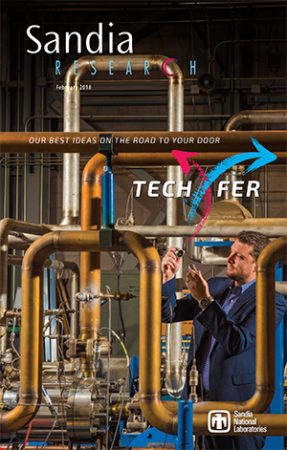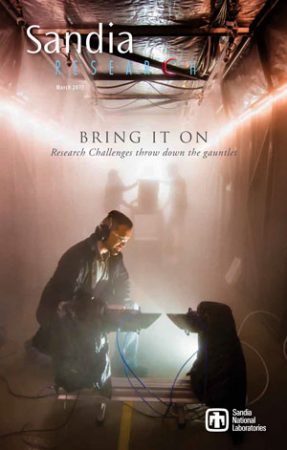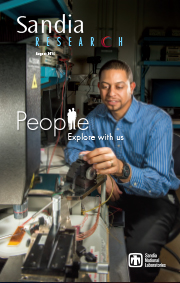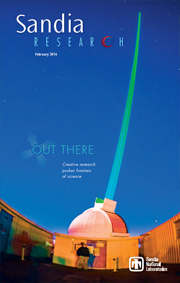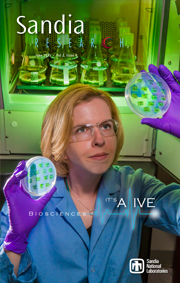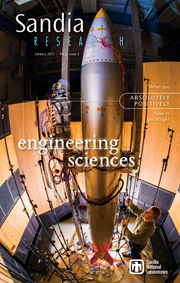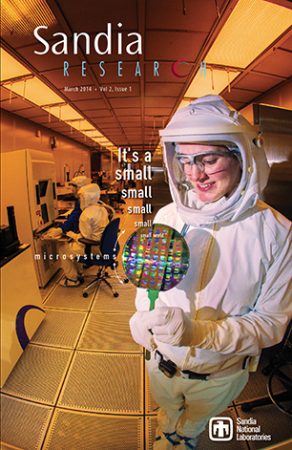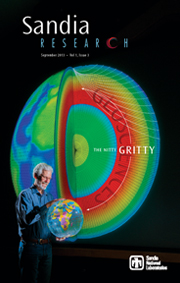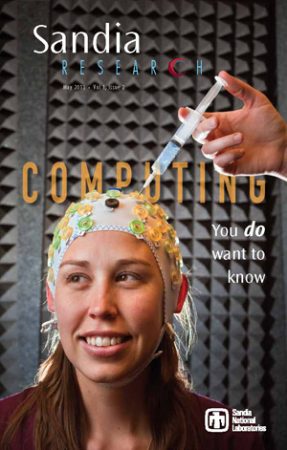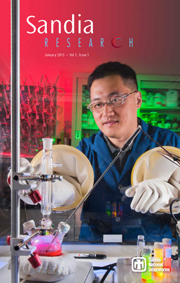Sandia Research was a quarterly magazine published from 2013–2018 highlighting Sandia's cutting-edge research and technology.
Results 1–49 of 49
RESEARCH MAGAZINE
Sandia Labs has bright minds tackling big challenges in science and engineering. That work creates a treasure trove of technology vital to national security but also to everyday life. From solid state lighting to medical diagnostics, the lab consistently hands over skills, knowledge and technologies to the private sector, and ultimately the public.
— Nancy Salem, Sandia Research magazine editor
(PDF, 16.7 MB)
RESEARCH MAGAZINE
“Research Challenges can address an issue that ’s important that might be outside the scope of what people are even thinking is possible today, and pursue it so that in 10 years we’ve got something ready to go. People might think, ‘Maybe that’s possible.’ We can say, ‘It’s not only possible, here it is.’ That’s what a national lab can do.”
— Rob Leland, former Sandia Labs vice president, Science and Technology
IN THIS ISSUE
RESEARCH MAGAZINE
“Sandia Labs is all about people. It takes the best and brightest to push the boundaries of science and engineering to new places. One tool to inspire research pioneers is Laboratory Directed Research and Development, which gives them the resources to explore the frontiers of possibility. We hire exceptional people and want to give them the opportunity to use their genius and creativity to find new ways to solve problems. The research freedoms offered by LDRD can launch a scientist to another level of accomplishment. Meet some of our most brilliant and interesting people on these pages.”
— Andy McIlroy
Deputy Chief Technology Officer
Director, Research Strategy & Partnerships
IN THIS ISSUE
RESEARCH MAGAZINE
"This issue of Sandia Research marks an important milestone in the history of Sandia and the other Department of Energy national laboratories. On Nov. 5, 1990, President George H.W. Bush signed the National Defense Authorization Act for FY1991, establishing the Laboratory Directed Research and Development (LDRD) program. The act authorized the laboratories to allocate a portion of their budgets toward innovative research and development that serves to maintain their scientific and technical vitality. In the ensuing 25 years, the LDRD program has played a vital role in our national security and defense and has led to an impressive array of technological advances, awards, patents and publications."
— Rob Leland
Chief Technology Officer
Vice President, Science & Technology
(PDF, 11.2 MB)
RESEARCH MAGAZINE
"The goal of Sandia’s bioscience work is to analyze, understand and control the functions of biological systems to meet national security challenges in biodefense, emerging infectious disease and energy security. For example, Sandia conducts research directed at helping defend against infectious disease outbreaks — such as the Ebola outbreak in West Africa — and bioterrorism, which have the potential to threaten human health, the economy and global security and stability."
— Malin Young
Director, Biological & Engineering Sciences Center
(PDF, 7.1 MB)
RESEARCH MAGAZINE
"In this issue of Sandia Research, you will see how Sandia continues to push the limits of engineering through the development of sophisticated predictive capabilities. As seen in the cover story, this requires the integration of physics discovery using advanced diagnostics and experimentation, physics model development, and advanced computational tools and methods that are validated and applied to support critical design decisions and product qualification. Another story looks into the quest by a team of Sandia researchers to ensure the accuracy of the computations relative to actual experimental data. As the team’s manager says, the work is fundamental to the lab’s technical foundation and the fulfillment of its unique national security mission."
— Justine Johannes
Director, Engineering Sciences Center
(PDF, 5.2 MB)
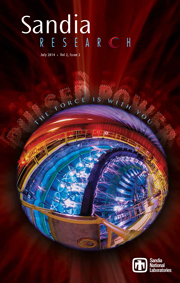
RESEARCH MAGAZINE
"In this issue, you will learn about the amazing capabilities of the Z Machine and the critical work it performs: ensuring the stockpile stewardship program has the data needed on material properties at the extreme conditions found in nuclear weapons; examining heat travel from the Sun’s center to its surface; investigating the existence of water on planets within and beyond our solar system; and resolving the age of white dwarf stars, which could determine the age of the universe itself. The long-term future of high energy density science is discussed, including our work on magnetized liner inertial fusion (MagLIF), a new and exciting approach to fusion, which, if successful, could eventually lead to high-yield fusion in the laboratory. You will also read about other important research tools, including the Qualification Alternative to Sandia Pulsed Reactor (QASPR), and meet some of the nation’s great scientists and engineers who are conducting this extraordinary research.”
— Mark Herrmann
Director, Pulsed Power Sciences
(PDF, 3 MB)
RESEARCH MAGAZINE
“This issue shows how Sandia is moving ideas from concept to reality. In it you will meet some of the nation’s great scientists and engineers who are making that happen. You will see how Sandia is laying the groundwork for quantum computing through its work on three Laboratory Directed Research and Development (LDRD) Grand Challenges. You will also see how Sandia is exploring the rapidly evolving area of light-matter interactions and is working to develop neuro-inspired computers for a variety of applications, from tracking and sensing to detecting patterns or anomalies in large complex data sets. Sandia performs this work and much more with a variety of partners to fulfill our vital national security mission.”
— Gil Herrera
Director, Microsystems S&T & Components
(PDF, 4.5 MB)
RESEARCH MAGAZINE
"In this fourth issue of Sandia Research, we've assembled a number of articles to give you a window into materials science research at Sandia, and a peek at some of the high-tech tools we develop and use. You'll also meet several of our leading materials researchers. From predicting materials performance at the nano and mesoscale to understanding hydrogen embrittlement to developing next generation semiconductor materials, our materials scientists participate in and have impact across the research-to-development-to-application spectrum."
— Carol Adkins
Director, Materials Science Research Foundation
(PDF, 8 MB)
RESEARCH MAGAZINE
"In this issue, we give readers a window into our portfolio of geoscience work that spans fundamental research to high-tech applications. The cover story shows the breadth of our research and the accompanying pieces introduce you to some of our researchers and the leading-edge projects they are working on. Geoscience expertise is essential to the safety and security of the United States and its citizens. We hope you see why in these pages."
— Marianne Walck
Director, Geoscience Research Foundation
— Mar
(PDF, 7.6 MB)
RESEARCH MAGAZINE
"Much of the current national security enterprise has come to rely on the exponential increase of computer performance commonly referred to as Moore's Law. In this issue, we give readers the opportunity to learn about the important cutting-edge work we are doing in the beyond-Moore arena. We also showcase our award-winning modeling code Xyce and discuss the many networking and interface problems our researchers are tackling."
— Robert (Rob) W. Leland
Director, Computing and Information Sciences
Research Foundation
— Robert (Rob) W. L
(PDF, 5.8 MB)
RESEARCH MAGAZINE
"With this issue, we are excited to debut Sandia Research as a window into the scientific work that forms the basis of our national security mission. We spotlight the cutting-edge research performed in the Labs' seven research foundations: Bioscience, Computing and Information Sciences, Engineering Sciences, Geoscience, Materials Science, Nanodevices and Microsystems, and Radiation Effects and High Energy Density Science. In addition, readers will meet some of the talented scientists who find solutions to the critical issues facing our nation."
— J. Stephen Rottler
Chief Technology Officer and Vice President
Science, Technology and Engineering Research Foundations
(PDF, 4.6 MB)
RESEARCH MAGAZINE
• From your drill to your car
• The links between water and energy
• Record-setting solar power
• Green jet fuel
• INSIGHTS: Petroleum Studies 101
(PDF, 4.1 MB)
RESEARCH MAGAZINE
• Sunshine to petrol
• Beauty, molecules deep
• INSIGHTS: Alliances form, products emerge
• Witnessing a birth
(PDF, 1.8 MB)
RESEARCH MAGAZINE
• Metals for tomorrow
• One step closer to fusion power
• INSIGHTS: Multiscale modeling and simulation
• Biofuels on tap
• Structures with smarts
(PDF, 3.9 MB)
RESEARCH MAGAZINE
• What to do about water
• INSIGHTS: When water disputes boil over
• Tragedy strikes
• Looking at immune response one cell at a time
• Summer in Antarctica
• Creating ice in nanoseconds
(PDF, 3.8 MB)
RESEARCH MAGAZINE
• Understanding climate change
• Sandia helps develop new wind turbine blade design
• Describing fundamental properties of materials
• Keeping watch on the world
• Assessing dental disease in minutes
• Computer simulation tracks nuclear contraband traffic
• Scaling down to the micro-dimension
(PDF, 4.8 MB)
RESEARCH MAGAZINE
• Expanding researcher access to microfluidic fittings
• Homeland Security chief dedicates new center
• Solving the riddle of the desert glass
• Applying high-performance computing to a scientific mystery
• Understanding ‘metallic water’
• Solar tower testing supports NASA plan
• Sandia — Monsanto Company announce cooperative agreement
• Detect-to-warn system offers lifesaving capability
• Keeping oil and gas control systems safe
• DOE selects Sandia Labs as Solid-State Lighting Center
(PDF, 4.2 MB)
RESEARCH MAGAZINE
• Sandia microshutter arrays aboard small NASA satellites
• Sandia wins two R&D 100 Awards
• Finding airplane short circuits before they cause trouble
• Determining wind turbine efficiency
• Testing living cells’ influence on nanostructure growth
• MiniSAR soaring with new deal
• Report faces future energy challenges
• Applying energy surety to military bases
• High-temp electronics open new era of devices
(PDF, 5.4 MB)
RESEARCH MAGAZINE
• Accelerating engineering innovation
• Winners think small
• Red Storm rising
• Thin film enables IC antifuses
• Salting away U.S. oil reserves
• SPR uses natural geologic features
• A drop in the bucket?
• Sandia foam no 'wipeout'
• Showing what experiments miss
(PDF, 2.5 MB)
RESEARCH MAGAZINE
• Safe ports-of-entry
• Improving fuel cell performance
• Understanding battery failure
• Coal, fuel of the future?
• ‘Riding the dimer’
• Going where no human dares
(PDF, 4.2 MB)
RESEARCH MAGAZINE
• Time traveling at the Nevada Test Site
• Sandia assists NASA with shuttle projects
• Solar tests benefit future NASA exploration
• Sandians earn national recognition
• Sandia wins four R&D 100 awards
(PDF, 5.9 MB)
RESEARCH MAGAZINE
• Our global water future
• Key to global economic security
• Cooperative modeling builds trust
• El Paso: Quest for liquid assets
• Following the desalination roadmap
• Jumpstart projects target success
• Desalination revolution: High risk/reward
• Reusing oilfield water
• Attacking arsenic in drinking water
• Energy-water nexus: facing the future
• Detecting toxins in the nation’s water supply
(PDF, 4.7 MB)
RESEARCH MAGAZINE
• Taking the terror out of terrorism
• Hydrogen from water at the nanoscale
• Nanotubes: Porphyrin versus carbon
• Detecting cancer ASAP
• Recovering from bio-attacks
• Nose for narcotics
• Assisting with shuttle rollout
(PDF, 0.9 MB)
RESEARCH MAGAZINE
• GM — Sandia advancing hydrogen storage
• Sampling ‘small atmospheres’
• Destroying biological agents
• Displaying gigapixel-sized images
• Shedding light on everyday problems
• Tough geo-tools aid earthquake research
(PDF, 1.5 MB)
RESEARCH MAGAZINE
• Improving automotive coatings
• Shaping future aircraft carrier operations
• Lowering the threat of future water wars
• Precision radar
• Sensing motion at the nanoscale
• Solar dish-engine project heating up
• Pursuing high-tech law enforcement
(PDF, 1.4 MB)
RESEARCH MAGAZINE
• Annealing — Microcosm in bent metal
• New membrane — Micro fuel cell moves closer
• Reliable, deployable — Sensor architecture
• Fire — Sandia-FM Global to collaborate
• R&D 100 — Sandia teams win Awards
• Small business — Sandia working for New Mexico
(PDF, 7.1 MB)
RESEARCH MAGAZINE
• Researchers “redesign” platinum
• ‘Nanotools’— Self-assembling durable nanocrystal arrays
• ‘Nanotractor’ studies micro-scale friction
• Cold Molecules — New avenue to the 5th phase of matter
• Sandia to lead Center of Excellence
• CRF — Measuring particulate emissions
(PDF, 12.5 MB)
RESEARCH MAGAZINE
• Yucca Mountain — Pursuing a license
• Tag-on sensor — Eliminating “friendly fire” during combat
• Synthetic Aperature Radar — MiniSAR offers promise
• Cooperative Monitoring Center — Amman targeting Middle East cooperation
• SARS Foam — Sandia foams fight SARS virus
(PDF, 11 MB)
RESEARCH MAGAZINE
• Practice: “As real as it gets”
• Scenario — Hitting a bullet with a bullet
• 3-2-1... Countdown pressure cooker
• KTF’s future a moving target
(PDF, 2.4 MB)
RESEARCH MAGAZINE
• The Shuttle: A probable cause
• Sandia developing ultra-high-temperature ceramics
• Sandia assists NASA’s HyTEx program
• Tailoring human implants
• New way to make white light
• Sandia, GTI address natural gas supply security
• New materials taking their cues from nature
• Lowering the cost of wind energy
(PDF, 1.5 MB)
RESEARCH MAGAZINE
• Trial by Fire
• Organizing for the Challenge
• Ready or Not
• Terrorism: How Vulnerable Are We?
• Unchecked Cargo: Assessing the Threat
• Conventional Explosives: Unconventional Solutions
• Robots to the Rescue
• “Souping up” Detection Hardware
• Shoe Bombs Disabled
• Detecting New Weapons of Terror
• Airport Tests Bio/Chem Technologies
• Master’s Degree in National Security
• DOE’s National Laboratories and Homeland Security by Penrose C. Albright
(PDF, 7.7 MB)
RESEARCH MAGAZINE
• Enhancing Long-Distance Collaborations
• More Powerful, Longer-Lasting Batteries
• Rings Around Earth
• New Reactor Probes Spent Fuel Reactivity
• Three Named to National Academy of Engineering
(PDF, 3.5 MB)
RESEARCH MAGAZINE
• Sandia Pursues Biotechnology
• Molecular Integrated Microsystems
• μProLab Speeds Protein Sorting
• Understanding Protein Interactions
• Imitating Nature with Adaptable Materials
• Powering Devices from Living Systems
• How a Bio-microfuel Cell Works
• Microarray Technology Helps Diagnose, Prevent Illness
• VxInsight Analyzes Data
• A Thousand Points of Light
• ‘Genomes to Life’ Program
(PDF, 2 MB)
RESEARCH MAGAZINE
• The Role of Sensing and Sensors
• Palm-top μChemLab™ Quickly Identifies Hazards
• Sensor-MEMS work shrinking μChemLab™
• Available Power for Remote Uses
• Analyzing Hazards from a Distance
• Micromachines and Sensors: the Road Ahead
• Biosensors Defend at Home, on Battlefield
• A Tale of Two Companies
(PDF, 3.5 MB)
RESEARCH MAGAZINE
• Let the Revolution Begin... Solid-state Lighting
• In the Heat of the Light
• Water by the Numbers
• Anatomy of a River
• Peace and Economic Development On the Border
(PDF, 1.4 MB)
RESEARCH MAGAZINE
• The Global Nuclear Future: An Overview
• Atoms for Peace
• Vision: a nuclear renaissance
• The Nuclear Fuel Cycle
• Nuclear Power 2010
• The Peaceful Atom
• Russia and U.S. Working Together
• After September 11
• Seeds of the Future
(PDF, 3.1 MB)
RESEARCH MAGAZINE
• Tech Transfer Boosts America’s Competitiveness, Strengthens National Security
• Licensing Anti-Terrorism Technologies
• Sandia-Goodyear Team up to Create a Better Tire
• Sandia-Intel Partnership Produces Rad-Hard Chips, Saves Taxpayers Millions of Dollars
• Science and Technology Park Fosters Sandia Partnerships
• EVUL: From Star Wars Technology to Worldwide Standard
• Spinning Off New Ideas for Commercialization
• Making Decisions for Seven Generations Native Americans Bring Traditional Perspectives to Technological Solutions
• VCSEL Technology Leads to Successful Spin-off Company
• Sandia/University Research Alliances Address Diverse Problems
• INSIGHTS: Tech Transfer
(PDF, 3.2 MB)
RESEARCH MAGAZINE
• Integrated Circuits Go Global
• Integrated Circuits Gain the Stamp of Approval
• The Emerging Science of Brazing
• New Approach to Process Control Revolutionizes Flame Spraying
• The LENS™ Success Story
• Machining in the Meso-Range
• Rooting for a Cause
• Buying Time
• The Virtual Captures the Reality
(PDF, 1.6 MB)
RESEARCH MAGAZINE
• Countering Emerging Threats:
⚬ Technologies for Asymmetrical Warfare,
⚬ Protection of our Homeland And Future Warfighting
• Developing Technologies for Asymmetrical Warfare and Homeland Defense
• Fielding New Systems for Countering Terrorism
• Meeting the Logistics and Demilitarization Challenges
• Modeling and Simulation: Who knows what evils lurk in the paths of robots?
(PDF, 1.6 MB)
RESEARCH MAGAZINE
• Developing the Energy Resources of a New Era
• Smart Technologies Revolutionize Drilling Techniques
• Smaller Energy Systems to Play Macro Role in Developing Future Energy Needs
• Islands in The Energy Stream: Ensuring Power-Flow Safety
• Safety Innovations in the Pipeline
• Dish/Stirling Provides Test for Secure Control System
• Sandia Program Promotes Renewable Energy Technologies In Mexico
(PDF, 2.2 MB)
RESEARCH MAGAZINE
• A Material World Materials science
• New Materials for Microsystems
• FAA Partnerships to Reduce Alloy Defects
• A Great IDEA for Materials Analysis
• Predictive Modeling Meets the Challenge
• Affordable Hydrogen Getter
• One Wafer, Many Tests
• Solving a Mystery Could Lead to New Material Properties
• Russian Cold Spray Technology Comes to Sandia
• Polymer Gels Used as Actuators on a Microscale
(PDF, 2.6 MB)
RESEARCH MAGAZINE
• An Age-Old Phenomenon; A Complex Challenge
• Witnessing A World of Violent Collisions
• “Supercar” Work Focuses on Reducing Emissions
• Laser Technique Spots Refinery Leaks
• Software is Indispensable Tool For Chemistry Modelers
• Not Just For Combustion Anymore
• Glassmaking Made Better
(PDF, 1.4 MB)
RESEARCH MAGAZINE
• Smart Machines — a robotics revolution
• Intelligent Systems and Robotics Center
• ISRC Technologies Meet the Challenge
• RIM Industry Booms
• From Medicine to Movies — Tomorrow’s World
(PDF, 653 KB)
RESEARCH MAGAZINE
• Peace in an Edgy World
• Comprehensive Test Ban Treaty: Expectations Vary
• Sandia’s Nonproliferation Technologies
• Material Protection, Control and Accounting
• Cooperative Monitoring Center
• Nuclear Transparency
(PDF, 650 KB)
RESEARCH MAGAZINE
• Z Provides Clues to Astronomical Mysteries
• VR Tool Helps Prepare for Terrorist Attacks
• A Dirty Task Gets Cleaner
• Building a Better Microsystem
• Remote Sensors Analyze Gases From Afar
• Controlling Quantum Dots
• Fine Resolution, Real Time Images
• Insights by C. Paul Robinson
(PDF, 706 KB)
RESEARCH MAGAZINE
• ASCI — The New Frontier
• News Notes
• Massively Parallel Computing, Sandia Software Key to Success
• ASCI Partnerships, Putting Technology to Work
(PDF, 1.2 MB)
RESEARCH MAGAZINE
• Mega Benefits, Microsystems
• News Notes
• At Sandia Microsystems Abound
• Satellites Get Smaller as They Take on Bigger Jobs
(PDF, 3.8 MB)
RESEARCH MAGAZINE
• Confidence By Design
• News Notes
• Surety as a Discipline
• Navigation Computational Wrong Turns
• Walking on eggs during and after the Cold War
(PDF, 2.6 MB)
